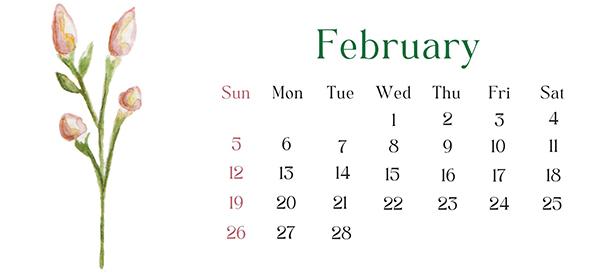
Foraging Calendar: What to Forage in February
You might think of winter as a time when the Earth rests. But Foraging in February can still be fruitful if you know where and what to look for.
So grab your basket and hit the trails to find all the delicious treats nature has to offer!
The USDA Hardiness zone Map is an attempt to divide the country into zones that give us some idea of whether certain plants can be grown in any given area. The primary piece of data used to delineate the zones is the average annual winter temperature experienced in that area. This could just be a list of forageables but the temperature varies so much across the U.S.A. The Lost Herbs wants this to be a list for every one of our readers no matter the zone or region you live in.
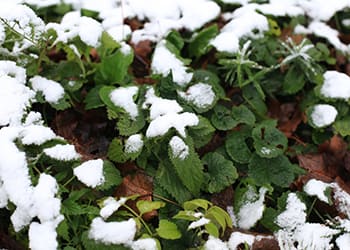 Stinging Nettle (Urtica dioica) Nettle stems are quite slender, square and grow 6 to 8 feet tall. Its leaves are thin, dark green with a tapered tip. The edges of the leaves are toothed and the leaf surface is distinctly veined and rather rough looking. Stinging nettle is packed full of nutrients and should always be blanched before eating. Stinging nettle grows across the United States in zones 4-10.
Stinging Nettle (Urtica dioica) Nettle stems are quite slender, square and grow 6 to 8 feet tall. Its leaves are thin, dark green with a tapered tip. The edges of the leaves are toothed and the leaf surface is distinctly veined and rather rough looking. Stinging nettle is packed full of nutrients and should always be blanched before eating. Stinging nettle grows across the United States in zones 4-10.
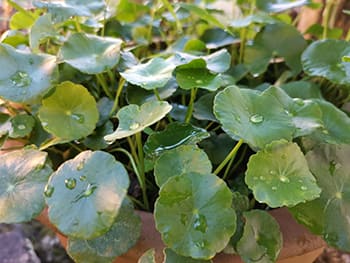 Pennywort (Centella asiatica) Leaves are round or kidney-shaped growing along the stem. Floating pennywort has fleshy leaves that are deeply lobed or have smooth to scalloped edges, and sometimes have a reddish spot at the point where the leaf stalk attaches to the stem. They grow in wetlands. Pennywort can be eaten cooked or raw. This plant grows in the North East in hardiness zones 6-11.
Pennywort (Centella asiatica) Leaves are round or kidney-shaped growing along the stem. Floating pennywort has fleshy leaves that are deeply lobed or have smooth to scalloped edges, and sometimes have a reddish spot at the point where the leaf stalk attaches to the stem. They grow in wetlands. Pennywort can be eaten cooked or raw. This plant grows in the North East in hardiness zones 6-11.
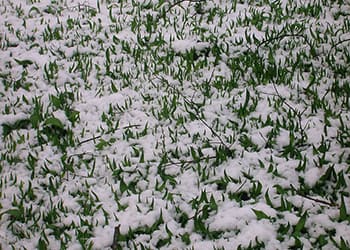 Wild Garlic (Allium ursinum) Wild garlic is a bulbous perennial with grass-like leaves that emerges in turf in the early spring. Leaves are slender, rounded, and hollow. Wild garlic is often mistaken for wild onion; however, wild onion leaves are more flattened and are not hollow. This punchy springtime herb can be used in pesto, garlic butter, soups, marinades and more. Wild Garlic grows across the Eastern United States in hardiness zones 5-9.
Wild Garlic (Allium ursinum) Wild garlic is a bulbous perennial with grass-like leaves that emerges in turf in the early spring. Leaves are slender, rounded, and hollow. Wild garlic is often mistaken for wild onion; however, wild onion leaves are more flattened and are not hollow. This punchy springtime herb can be used in pesto, garlic butter, soups, marinades and more. Wild Garlic grows across the Eastern United States in hardiness zones 5-9.
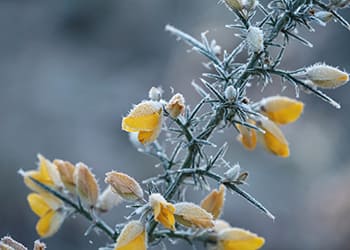 Gorse (Ulex europaeus L.) Gorse produces a profusion of yellow, pea blossom shaped flowers that form at the ends of branches from early spring to late summer. The spiny leaves are the best way to differentiate gorse from scotch broom which generally has three-parted, non-spiny leaves. Gorse was used in Irish folk medicine to treat asthma and other respiratory illnesses as well. The flowers have a mild coconut flavor and make a great garnish to any dish. Gorse grows in the north east in hardiness zones 6-10.
Gorse (Ulex europaeus L.) Gorse produces a profusion of yellow, pea blossom shaped flowers that form at the ends of branches from early spring to late summer. The spiny leaves are the best way to differentiate gorse from scotch broom which generally has three-parted, non-spiny leaves. Gorse was used in Irish folk medicine to treat asthma and other respiratory illnesses as well. The flowers have a mild coconut flavor and make a great garnish to any dish. Gorse grows in the north east in hardiness zones 6-10.
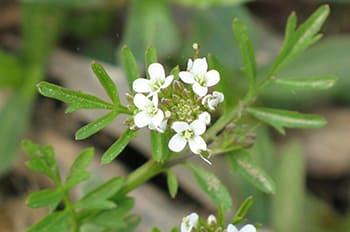 Pennsylvania Bittercress (Cardamine pensylvanica) grows 6 to 24 inches high on an erect to spreading stem. Stems may have a few hairs and may take on a reddish color in full sun. The flowers are each held on an ascending stalk, are 4-parted with a tubular calyx that has 4 oblong sepals with obtuse tips; sepals are green at the base and shade to purple at the tip. The four petals are white, much longer than the sepals, spatulate in shape and have rounded tips. The root can be grated and used as a flavoring. The flavor of this plant is similar to broccoli rabe but much milder. This plant grows on the east coast through Florida in hardiness zones 4-8.
Pennsylvania Bittercress (Cardamine pensylvanica) grows 6 to 24 inches high on an erect to spreading stem. Stems may have a few hairs and may take on a reddish color in full sun. The flowers are each held on an ascending stalk, are 4-parted with a tubular calyx that has 4 oblong sepals with obtuse tips; sepals are green at the base and shade to purple at the tip. The four petals are white, much longer than the sepals, spatulate in shape and have rounded tips. The root can be grated and used as a flavoring. The flavor of this plant is similar to broccoli rabe but much milder. This plant grows on the east coast through Florida in hardiness zones 4-8.
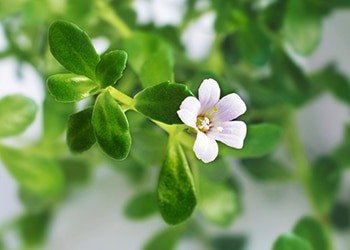 Brahmi (Bacopa monnieri) has soft, hairy stems and bright green, oval, succulent leaves. Its flowers are small and white with yellow centers. It is completely edible and is very popular as a medicine when it is steeped into tea, mixed with oil, or worked into a paste. Research is being done on Brahmi as an alternative ADHD medication to Adderall. Brahmi is mostly used as medicinal herb ground to promote brain health. Brahmi grows in America’s wetlands mainly in Florida in hardiness zones 8-11.
Brahmi (Bacopa monnieri) has soft, hairy stems and bright green, oval, succulent leaves. Its flowers are small and white with yellow centers. It is completely edible and is very popular as a medicine when it is steeped into tea, mixed with oil, or worked into a paste. Research is being done on Brahmi as an alternative ADHD medication to Adderall. Brahmi is mostly used as medicinal herb ground to promote brain health. Brahmi grows in America’s wetlands mainly in Florida in hardiness zones 8-11.
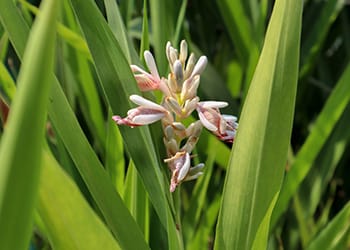 Galanga (Alpinia galanga) is a perennial herb. The rhizomes are cylindrical and branched, hard, reddish brown or pale yellow-green, with a strong smell. The leaves are oblong, and alternate. The plant has many flowers that are white or yellowish, and fragrant. Although it looks like ginger, you can identify galangal by its lighter skin and tougher flesh. Galanga has been traditionally used for many years to treat several different illnesses including cold, pain, inflammation, stomach ache, and it also is an antioxidant. You can use Galanga as a replacement for ginger. Galanga grows in Florida in hardiness zone 9-11.
Galanga (Alpinia galanga) is a perennial herb. The rhizomes are cylindrical and branched, hard, reddish brown or pale yellow-green, with a strong smell. The leaves are oblong, and alternate. The plant has many flowers that are white or yellowish, and fragrant. Although it looks like ginger, you can identify galangal by its lighter skin and tougher flesh. Galanga has been traditionally used for many years to treat several different illnesses including cold, pain, inflammation, stomach ache, and it also is an antioxidant. You can use Galanga as a replacement for ginger. Galanga grows in Florida in hardiness zone 9-11.
⇒ How to Make Bark Bread from a Tree That Grows on Almost Every Street in America (Video)
While all of these are located in America, we don’t want to leave our overseas readers out of the loop. Countries like Canada and Australia are also abundant with delicious plants.
Canada’s weather aligns more with the United States and many of the plants above can grow in Canada’s ecosystem. Canadians can use the hardiness zones to apply to their regions.
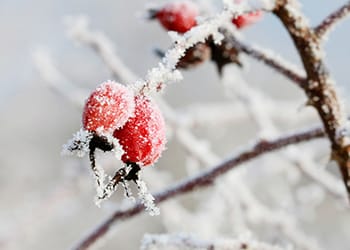 Rose Hips (Rosa canina) are the fruit of any rosebush. They are red to orange in color, oblong or round in shape, often with small wisps of “hair” protruding from the bottom of the rose hip. Rose hips come in all shapes and sizes, from large to small. Some rose hips, such as those from the dog rose, are more oblong in shape. All Rose hips are edible. Rose hips make great jellies, sauces, syrups, soups and seasoning, and even fruit leather. Rose Hips grow in hardiness zones 3-9.
Rose Hips (Rosa canina) are the fruit of any rosebush. They are red to orange in color, oblong or round in shape, often with small wisps of “hair” protruding from the bottom of the rose hip. Rose hips come in all shapes and sizes, from large to small. Some rose hips, such as those from the dog rose, are more oblong in shape. All Rose hips are edible. Rose hips make great jellies, sauces, syrups, soups and seasoning, and even fruit leather. Rose Hips grow in hardiness zones 3-9.
Australia lies in Plant Hardiness Zones 7 through 12 with some variations across regions and seasons. The caveat with foraging in Australia is it is completely illegal without a permit except private properties in some places. Without the 104$ permit you can be fined anywhere from 10,000 to 110,000 dollars depending on where you foraged. If you have a license or are on your own land you can forage freely.
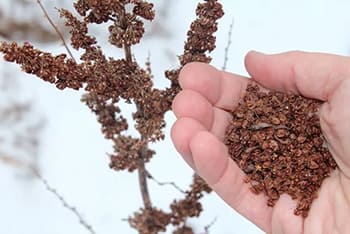 Dock (Rumex) has a small, thin sheath that covers the base of each dock leaf. This is called the ocrea, and it turns brown as the plant ages. Dock plants form rosettes of large oval green leaves with distinct midribs. Broadleaf dock leaves are flat, while curled dock has curly-edged leaves. Docks seeds can be ground up for flour while the leaves can be used to treat Nettle stings. Dock grows in hardiness zones 4-8.
Dock (Rumex) has a small, thin sheath that covers the base of each dock leaf. This is called the ocrea, and it turns brown as the plant ages. Dock plants form rosettes of large oval green leaves with distinct midribs. Broadleaf dock leaves are flat, while curled dock has curly-edged leaves. Docks seeds can be ground up for flour while the leaves can be used to treat Nettle stings. Dock grows in hardiness zones 4-8.
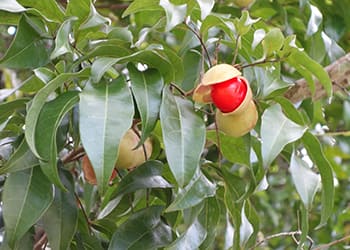
Small Leaved Tamarind (Diploglottis campbellii) Small-leaved Tamarind is a small, dense tree that produces large orange fruits with a delicious, tangy pulp. This species grows natively in the rivervine rainforest areas of New South Wales and Queensland. The flavor is refreshingly tart with a distinctive taste that lends well to both sweet and savory dishes. Recipe favorites include jams, jellies, sauces, fruit chutneys, spreads and coulis. It grows in hardiness 10-12.
J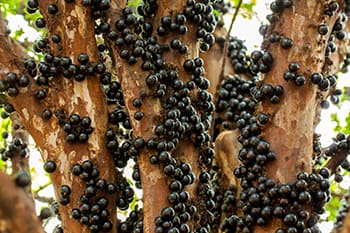 aboticaba (Plinia cauliflora) is a tropical to subtropical evergreen tree or large shrub that bears edible, thick-skinned, grape-like purple fruits with a sweet, juicy, gelatinous, white pulp. It is most recognizable by the large, spherical, dark purple fruits that grow directly from its trunk. The fruit can be eaten raw or cooked. Jaboticaba grows in hardiness zones 9-11.
aboticaba (Plinia cauliflora) is a tropical to subtropical evergreen tree or large shrub that bears edible, thick-skinned, grape-like purple fruits with a sweet, juicy, gelatinous, white pulp. It is most recognizable by the large, spherical, dark purple fruits that grow directly from its trunk. The fruit can be eaten raw or cooked. Jaboticaba grows in hardiness zones 9-11.
While some of these plants may be hard to find without a keen eye, foraging in February is an excellent way to get outdoors and experience the natural world while also providing a tasty and healthy snack. And with the right knowledge, you can find an abundance of fresh, nutritious food to enjoy during the cold winter months.
Let us know what are your favorites to forage this time of year in the comments!
You may also like:
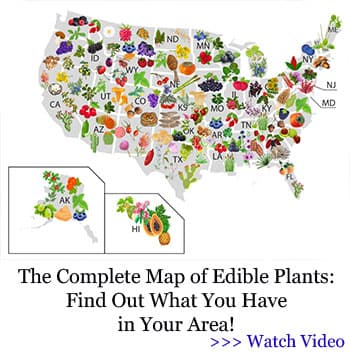 The Medicinal Benefits of Your State Flower
The Medicinal Benefits of Your State Flower
The Hidden Food Growing Fence (Video)
The Toothache Plant That Every Herbalist Should Grow

We all need to know what weeds are edible.
White clover is abundant down here in South Louisiana right now. I made some tea from the blossoms because I was feeling ill the other day. After drinking it I felt 100% better. The next day it was as if i had never been sick. God’s pharmacy is the absolute best!
And thank you, Lost Herbs. You have woken the forager and medicine woman inside of me. This knowledge is priceless. Thank you!
Good day: I have your book and am very interested in all the rest of your information. I live in Canada and am sure many others would also like to receive your wonderful insight. Would it be possible to get anything you might have for us here in the north?
I’m up in Northern Minnesota and was curious as to what we could forage here. There is nothing green here at all for the next couple months. Are the barks or anything from trees ?
Chaga should be harvested in late winter.
I also have your book and would love any information for up here in Canada 🙂
Love the book and can’t wait to start forging
how do we in Australia correlate with your information as our hemisphere’s are so different
Hello Rob,
Thank you for your interest in our article!
Your feedback is very important to us. It means that we can better understand what we are doing well, and where there are areas where we need to make improvements.
Unfortunately, we cannot always include all the information in such a short article. The February forageables mentioned in this article are Dock, Small-leaved tamarind and Jaboticaba.
We recommend getting in touch with a local forager to learn more about the delicious edibles that you can find in your country this time of the year.
Many blessings and good health!
Hi, I’d just like to ask, are you based in America ? Because when I look at your foraging diary its all about zones and plants in America. I’m from England, do you do foraging calendars for England ?
Hi Shirley,
Thank you for your interest in our article!
The Foraging Calendar series is indeed dedicated to North America. Unfortunately, we cannot always include all the information in such a short article.
We recommend getting in touch with a local forager to learn more about the delicious edibles that you can find in your country this time of the year.
Many blessings and good health!
The Pennywort looks like like the weed we call “dollar weed” here in Lower Alabama (USA). Does the plant you describe grow in sourthern United States?
Molly, I have that same question! I live in Baldwin County.